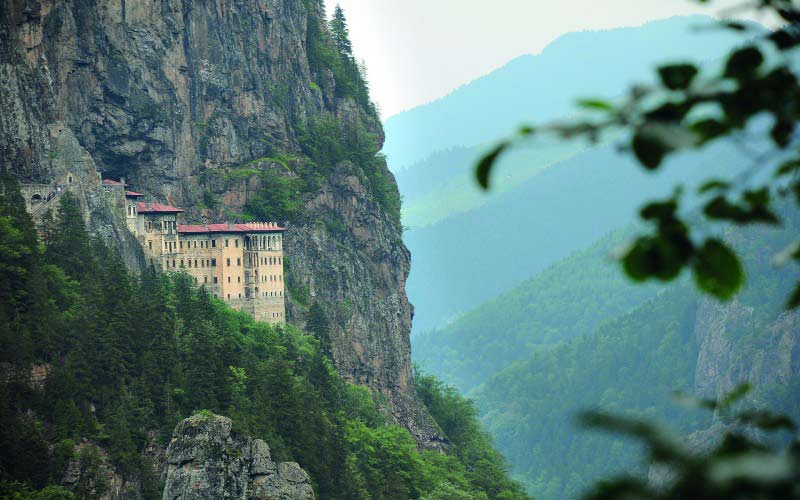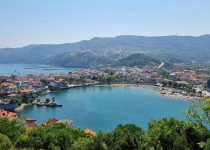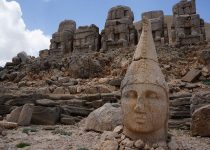Explore The Royal Elegance Of The Dolmabahce Palace In Turkey
Dolmabahce Palace symbolizes royalty and prosperity and simultaneously signifies the mighty Ottoman Empire’s fall. This majestic grand palace offers a royal elegance that oozes luxury from all quarters. The grand palace was built using rich materials that are quite evident from its luxurious exteriors and interiors, symbolizing the greatness of the Ottoman Empire and its might in the 19th century. This grand palace, commissioned by Sultan Abdul Mecit in 1843, is also the largest mono-block palace in Turkey. We have collated some amazing facts about the Dolmabahce Palace that will make you browse through the magnificent pages of history and explore this place at the earliest.
Reaching the Dolmabahce Palace
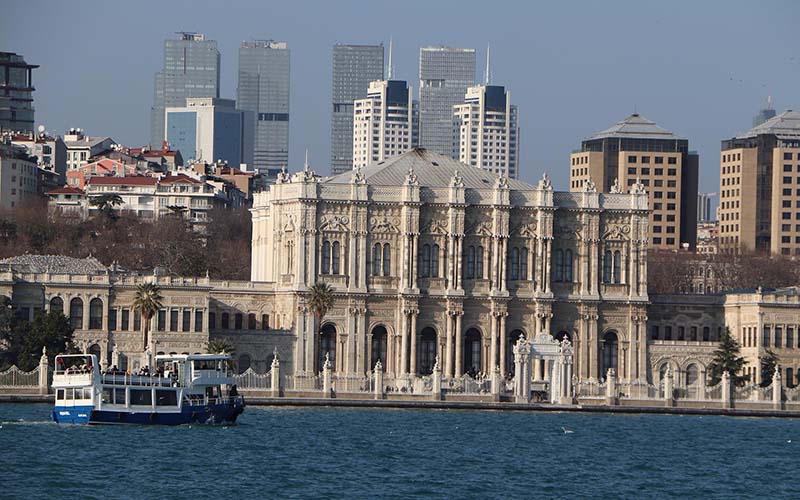
The palace can easily be accessed by bus or tram by taking the TB2 line bus or the T1 line tram that goes to Kabatas. From the Kabatas terminal, head 1 km northeast of the station to reach the palace. This palace is also located 5 km from Sultanahmet Square and 1.5 km from Taksim Square if you want to drive down.
The rich cultural heritage of the Dolmabahce Palace
The grand palace in Turkey has a rich history that brings in a story of European wealth rivalry and oriental magnificence. This masterpiece was built on the order of Abdulmecid I, who wanted to show the world the charm and mighty of the Ottoman Empire. We were always fascinated by his European counterparts who lived in equal elegance at their respective European residence. The Armenian Balyan family initiated the construction between 1842 and 1853. Abdul Hamid II relocated his residence to the Yildiz Palace in 1889. Subsequently, in 1920, the palace became the President’s official residence, Mustafa Kemal Ataturk, also the founder of the Republic of Turkey. The unique history during its construction made it one of the standout landmarks in the 19th century that continued to woo the tourist world each year. The palace was turned into a museum post his death in 1938. In 2007, this palace became the Prime Minister’s official residence in Turkey.
Architectural facts of the Dolmabahce Palace
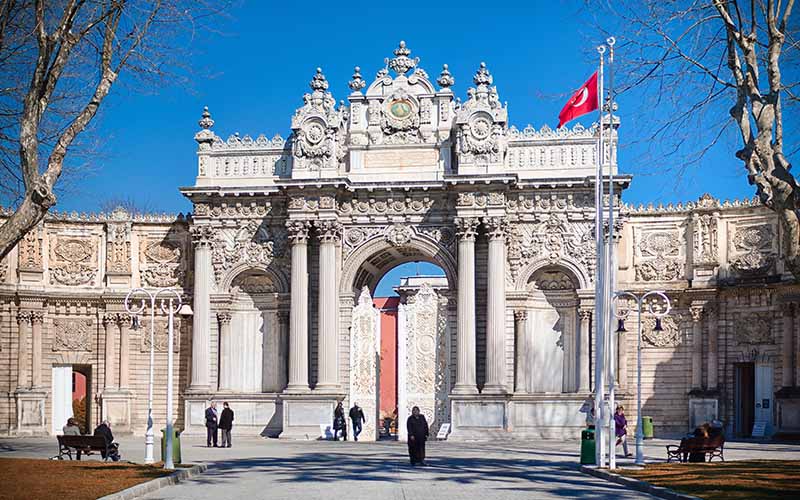
As stated earlier, Abdulmecid wanted this palace to be equally charming and elegant as his European counterparts, which is quite evident in the distinguishing features of this royal architecture. Today, the visitors who browse through the Dolmabahce Palace are wooed by the incredible architecture of this masterpiece. So many buildings, a mosque, a library, a clock tower, and a harem are part of the palace complex spread over 110,000 square meters. The Baroque style elements incorporated in the Dolmabahce Palace were unique and odd for the eastern culture that is still evident and the prime reason why it continues to impress the audience even today.
The beautiful Interiors of the Dolmabahce Palace
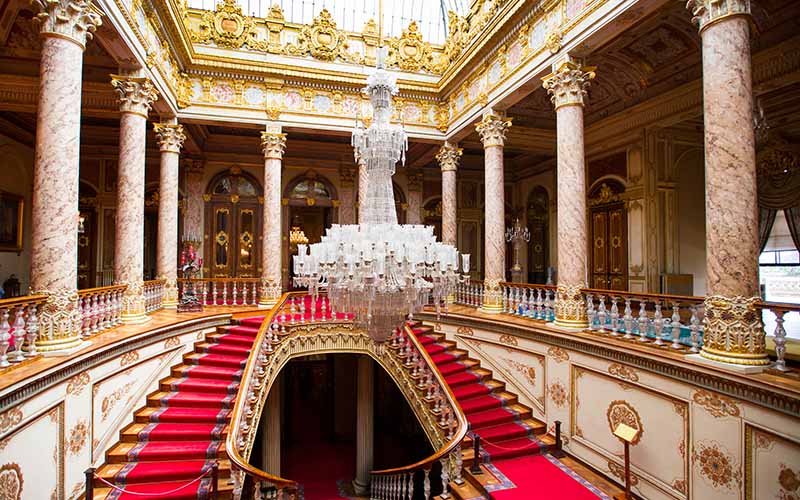
The palace’s interior decoration is unique compared to the region’s elegant palaces. The elements that were used reflect the rich history that it possesses. Gold-cited ceilings decorate the interiors of this palace to indicate the might of the Ottoman Empire at that time. Queen Victoria gifted the Sultan 5 tons of bohemian glass chandeliers that are visible today. The cost of building this grand and unique palace was equivalent to 5 million pounds of gold. You will find several dotted collections of Aivazovsky’s artwork and paintings, masterpieces dotting the various corners of the palace. All these paintings were created at the special request of the Sultan. The clocks in the palace indicate when President Ataturk died, which is 9:05am. The grandeur of this palace is so special that it still stands among the most gorgeous palaces in the entire region and Europe. Each element in the palace speaks about the opulent lifestyle of the various residents.
The gorgeous exteriors of the Dolmabahce Palace
The palace was built on the small bay of the Bosphorous. This bay eventually transformed into an imperial garden at the start of the 18th century. The name, Dolmabahce itself is derived from two words – dolma means filled, and bahce means garden. Several pavilions and mansions were built as synonymous with the Sultan and Ottoman culture during the 18th and 19th centuries. These collections led to the complex called the Besiktas Waterfront Palace, which was demolished by Sultan Abdul Mecit to reconstruct the Dolmabahce Palace. Each part of the palace was redesigned keeping his taste in mind, and such was the elegance and luxury of this palace that he eventually decided to shift his residence from the Topkapi Palace to the Dolmabahce Palace.
The extravagance and elegance of the Dolmabahce Palace
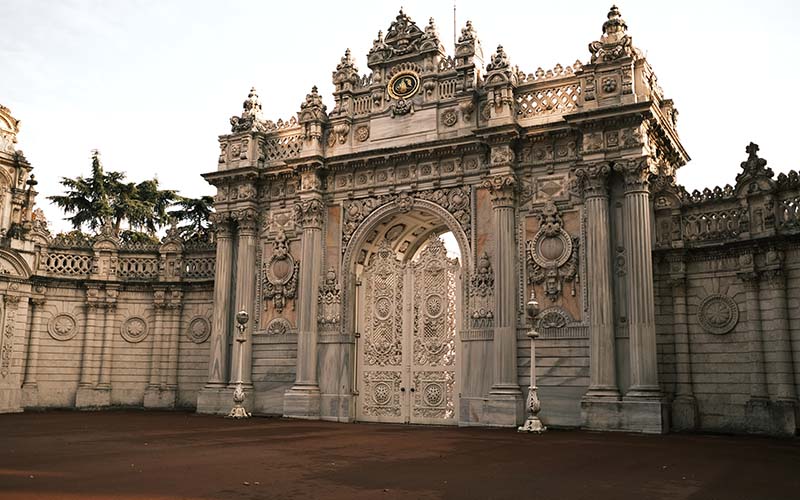
Even though the palace showcases the opulent and elegant lifestyle nature of the Ottoman Empire, the fact is that this palace was built to cover up the decline of the grand empire. The grandeur and charm of this palace were all set to impress the world, and the only way to do this was by incorporating unique elements and style in its construction. Therefore, the Ottoman tradition of building pavilions was completely restructured into a mono-block European-style palace. The reconstruction was Led by a leading Ottoman architect, Garabet Baylan, and his son, Nigogayos, in 1843 and completed in 1856.
The results were amazing as this two-floor palace dotting an area of 45000 square meters featured 285 rooms, 6 hammams or Turkish baths, 44 halls, and 68 washrooms. A fusion of Baroque, Neo-Classic, Rocco, and traditional Ottoman art and cultural elements is used in its design, leading to its uniqueness even today. The ceilings are decorated with 14 tons of gold, representing this palace’s lavishing royalty. In addition, the palace also features the largest worldwide collection of Baccarat and Bohemian crystal chandeliers, some gifted by Queen Victoria to the Sultan. Finally, you will be amazed by the price tag of the eventual construction – a staggering 5 million Ottoman gold coins equivalent to 35 tons of gold today.
The Royal residents of the Dolmabahce Palace
The Dolmabahce Palace witnessed six residing sultans from 1856 till 1924, leaving a 20-year gap between 1889 and 1909 where the Yildiz Palace was used. Once the Republic of Turkey was formed, President Mustafa Kemal Ataturk turned this into a presidential house. This period saw major changes like introducing a new alphabet. But unfortunately, he was never in good health after shifting here. He eventually died at 9:05 am on November 10, 1938. To honor his work and presence, all the clocks in the palace indicate the same time. Today, the room where he passed away is part of the palace-guided tours offered to visitors.
Entry fee and visiting hours
The entry fee to witness the Harem and Selamik sections is 300 Lira. You will have to pay additional to explore the exhibitions and kiosks placed. Children below 6 years do not have an entrance fee. Photography is strictly prohibited inside the palace buildings. There are cafes inside the palace near the museum grounds to grab a quick bite during your discovery journey. The operational timing for purchasing the tickets is 9 am to 4 pm. However, as the entry is limited to 3,000 people only, the entry can be closed earlier.
Know Before you Go
Location- The Dolmabahçe Palace is placed on Dolmabahce Road in the Vezneciler area of Istanbul, Turkey.
Opening Hours- This is open to tourists daily from 9 a.m. to 4 p.m., excluding Mondays and Thursdays when it is closed.
Ideal Time to Visit- The best time to visit Turkey for Dolmabahçe Palace is from March through May, during the spring season, when Istanbul has mild weather perfect for exploring the palace and grounds. Since this palace opens early, you may take your time welcoming the architectural splendor. However, avoid the busiest hours between 10 a.m. and 2 p.m. when there are ample visitors. You may find it more pleasant and relaxed, particularly early in the morning or late in the afternoon as closing time approaches. Also, weekdays, from Tuesday to Thursday in particular, tend to have fewer crowds, enabling a calm, unrushed exploration.
Why Visit Dolmabahce Palace?
- Dolmabahçe Palace, the biggest single-block palace in Turkey, has 258 rooms and 46 halls that provide visitors with an extensive opportunity to explore its magnificent splendor.
- Its historical significance as the official home of six Sultans and a Caliph from 1856 to 1924 provides an extremely fascinating aspect.
- See Ottoman architecture at its best. It has a focal lobby with chambers and a main hall bordered by rooms that fascinate historians and architecture buffs.
- It has used over 14 tons of gold to decorate its ceiling and various buildings inside, offering a look at the affluence of the Ottoman period.
- An exquisite bohemian crystal chandelier, believed to have been gifted by Queen Victoria, enriches the palace’s majestic ambience.
- Dolmabahçe Palace contains an impressive collection of paintings by Turkish and Western artists, making it a great destination for art lovers. The palace provides a rich and diverse visual experience with its array of artwork.
- With the scenery of the Bosphorus Strait as its backdrop, the palace and its lush gardens provide stunning vistas, a delight for nature enthusiasts and photographers.
- The palace standing today is a testament to Turkey’s historical development, as it functioned as the Presidential Palace for Kemal Atatürk, the founding leader of the modern Republic of Turkey.
- A tour of the palace gives a one-of-a-kind look into the way of life of Ottoman royalty through the palace’s conserved original furnishings and lavishly ornamented insides.
- With its captivating combination of historical significance, architectural design, and artistic beauty, Dolmabahçe Palace offers an enriching and unforgettable visit for all who come. It is one of the best family friendly places to stay in Turkey.
FAQs
Q1. When was the Dolmabahce Palace constructed?
It was built between 1843 and 1856 by Abdulmecit, the 31st Ottoman Sultan.
Q2. Who designed it?
Dolmabahce Palace, 19th-century Ottoman architecture designed by Garabet Amira Balyan and Nikogos Balyan, replaced Topkapı Palace in 1843-1856 to compete with European monarchs’ homes.
Q3. What is its architectural style?
Dolmabahçe Palace, a blend of Eastern and Western architectural styles, features a crystal staircase with Baccarat crystals and stunning Bosphorus views, reflecting Istanbul’s cultural diversity.
Q4.What is the total number of rooms?
Dolmabahçe Palace boasts 285 rooms, each adorned with intricate designs, showcasing the royal lifestyle of the Ottoman Empire, enhancing its historic grandeur and splendor.
Q5. How much time is needed to explore the palace?
The guided tours of the palace take around one to one and a half hours to fully explore.
Q6. How to reach the palace?
Getting to Dolmabahçe Palace is quite easy. You can ride the T1 tram to the Kabatas station, then walk a short distance. Or, you can take the Bosphorus ferry to Besiktas, then enjoy a picturesque stroll. Taxis are plentiful in Istanbul if you want a more direct path. Buses like routes 25E, 40, 42T, and DT2 also provide other ways to get there.
Q7. What are its timings?
The Dolmabahçe Palace can be seen between 9 a.m. and 5:30 p.m. from Tuesday to Sunday. The palace does not admit visitors on Mondays.
Q8. Is it wheelchair accessible?
The Dolmabahçe Palace is wheelchair-accessible. It has ramps and other features, allowing all types of visitors to appreciate its beautiful architecture and rich history.
Q9. Is photography permitted?
Dolmabahçe Palace prohibits photography to protect antiques, textiles, and intricate designs, while maintaining the palace’s serenity and allowing visitors to immerse themselves fully in its rich heritage.
Q10. Is it worth visiting?
Dolmabahce Palace, once Mustafa Kemal Ataturk’s presidential residence, now houses a museum showcasing 50,000 historical artifacts, lavish furnishings, and hand-crafted silk rugs, showcasing Turkey’s modernization of the old Ottoman Empire.
